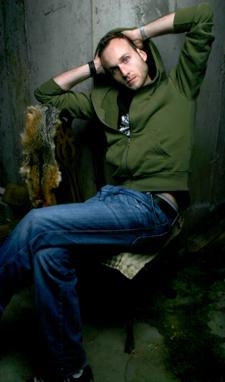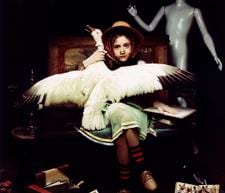
Credit: Photos courtesy of J Hobin
Robin and Richard were two pretty men,
They lay in bed till the clock struck ten.
Believe it or not, this titillating little rhyme was penned by none other than Mother Goose herself. While most people generally equate nursery rhymes with young children and innocent playtime, the original poems are, in fact, more adult than we might think.
Taking a closer look at the intricacies of the rhymes of Mother Goose is gay artist Jonathan Hobin. Fascinated with the darker side of childhood, Hobin has created a photo exhibit that depicts young children in fairytale scenes based on a handful of carefully selected nursery rhymes. Mother Goose will be on display at the Dale Smith Gallery Mar 6 -31.
“I don’t consider myself a photographer, but a creator of these weird tableaux,” says Hobin, a graduate of Canterbury High School and Ryerson University. “I love images because I love creating a story. I’m always throwing as much shit into a photo as possible. More is more. There is always room to fit something else in. These are dark and weird tableaux, but hopefully they look beautiful at the same time. Ugly in a pretty way? There’s some beauty in the fact that something can be so tragic. It evokes something.”
Methodically constructed with every detail in mind, Hobin’s photographs illuminate a number of serious issues — such as spousal abuse, unplanned pregnancy, abandonment, depression, loneliness, eating disorders and phobias — that directly or indirectly affect young children.
“Nursery rhymes were repeated to children, not only to warn them, but as a way of sculpting and directing them. Some would consider religion, for example, to be a tool to control society. Likewise, children were made to memorize verses for the purpose of controlling behaviour. Nursery rhymes thrived in an illiterate time because they were easy to put to memory,” explains Hobin.
One image shows an arrogant young Peter Peter Pumpkin Eater keeping watch over his child-bride trapped in a pumpkin shell with orange innards strewn across her hair and face. Another photo shows Little Jumping Joan dressed in a straitjacket: kept in isolation and surrounded by white-washed walls, her only companions are a scattering of feathers and a dusty phonograph.
“When you feel vulnerable to your emotions, or maybe to a predator, kids have this notion that they are alone. They realize their own limitations. Something happens and then they are aware that they aren’t necessarily protected. Mommy and Daddy can’t protect them from everything,” says Hobin, who was very particular about the children he chose as models for his images.
“You might notice these are the same three kids in all the photos,” he points out. “They are family friends, and their father died suddenly just before the youngest turned four. They suffered through tragedy: if there are any kids that understand that life is not free and easy, then it’s these kids. They understand a lot more than you would think. I could go with them to this darker place; I knew they would be able to understand. They totally represent the type of kid I was at that age.”
Keen on sharing stories about his youth and discussing the complex process of growing up, the artist admits that he still has a “love-hate relationship” with his childhood. Even though he was raised in an open-minded and creative family environment, still Hobin remembers himself as a nervous and introspective child, very much aware of the world around him.
“It’s like a tuning fork: once struck, the vibration is amplified by things operating at the same frequency. So a person who experiences pain only notices pain in the world, as that is the frequency they are tuned into. The frequency of joy and love can get lost. I think I was like that. I had a lot of friends and people liked me, but I focussed a lot on the darker side of life. Children become aware of darker side; they become skeptical. God bless those kids that can ignore all that.”
“If I do have ‘kid’ issues or ‘Mommy and Daddy’ issues, maybe I’m working things out with photography. Or maybe I already worked it out, and this is my way of acknowledging it,” says Hobin. “I survived that period of time in my life. I am definitely obsessed with anything to do with youth and my childhood. Once you go back to the emotions of that time in your life, you have the drive to be creative again; it’s more guttural.”

 Why you can trust Xtra
Why you can trust Xtra


